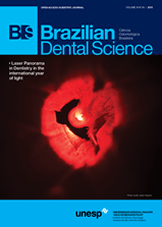Non-familial Cherubism – Report of a case
DOI:
https://doi.org/10.14295/bds.2015.v18i4.1137Abstract
Introduction: The Cherubism is a rare disease that affects the middle and lower third of the face in individuals at the time of childhood. It is a rare hereditary benign bone disease with an autosomal dominant inheritance. The familial distribution may affect different generations and isolated non-familial cases have also been reported in literature. Lesions appear as cystic multilocular radiolucencies, histologically, resembles central giant cell granluloma and hyperparathyroidism brown tumor with numerous randomly distributed multinucleated giant cells and vascular spaces within a fibrous connective tissue stroma. Objectives: The aim of this study is to report the importance of the diagnosis of this pathology and the variety of treatments available in the literature, thus guiding to an individualized treatment. Case Report: Caucasian 8 years-old female, in good general condition, was referred to Service of Oral and Maxillofacial Surgery of Erasto Gaertner Hospital (EGH), Curitiba – PR, Brazil, complaining of bilateral swelling of the maxilla and mandible since 4 years-old. Apparently, the girl is the first one who developed the genetic pathology in at least 4 generation of her family. After biopsy, cherubism diagnosis was confirmed and the treatment of choice was periodic monitoring. Discussion: Cherubism studies with long-term follow-up with clinical and radiographic documentation indicate that the spontaneous resolution of bone lesions is rare. Treatment of cherubism is controversial and various modalities have been reported as the use of calcitonin, osseous plasty surgery, curettage, orthognathic surgery, liposuction and palliative treatments.Downloads
Downloads
Published
How to Cite
Issue
Section
License
Brazilian Dental Science uses the Creative Commons (CC-BY 4.0) license, thus preserving the integrity of articles in an open access environment. The journal allows the author to retain publishing rights without restrictions.
=================




























